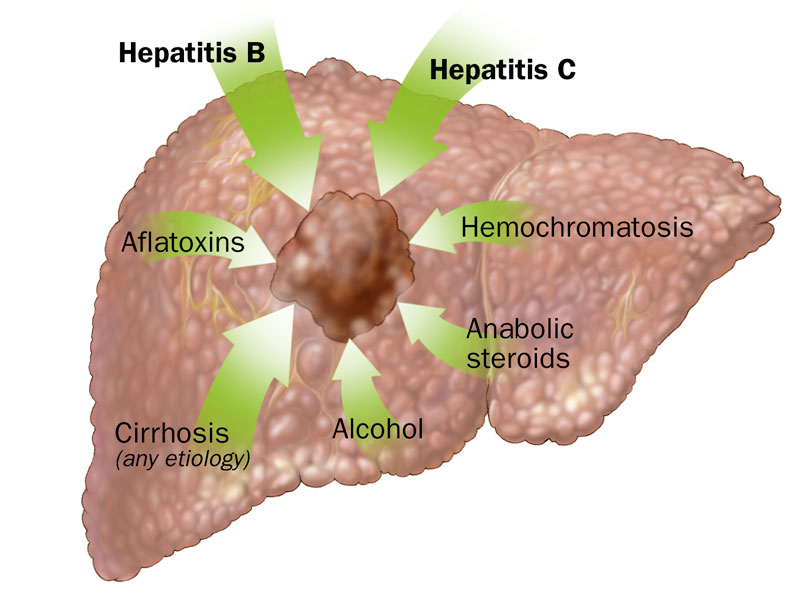

Tumors are groupings of abnormal cells that cluster together to form a mass or lump. When a tumor develops in the liver, the organ is unable to function properly.
Tumors of the liver - a large, reddish organ in the abdomen that produces proteins and digestive juices, stores energy, and removes toxins from the body - can be benign (not cancerous) or malignant (cancerous).
Most benign liver tumors are present at birth, and are usually the result of abnormal tissue growth while the fetus was developing. The most common type of benign liver tumor is called a mesenchymal hamartoma. Though these tumors do need to be removed through surgery, kids who have them generally do not require further treatment or experience long-term problems.
Malignant liver tumors occur less frequently and typically require more aggressive treatment, such as chemotherapy, radiation, or surgery. The two most common types of liver malignancies are called hepatoblastoma and hepatocellular carcinoma.
Early on, a child with a benign or malignant liver tumor might have few symptoms - or none at all. As the tumor grows, however, the following symptoms may develop:
1. a lump that can be felt in the abdomen, or a swollen abdomen
2. pain on the right side of the abdomen, where the liver is located (if the tumor is pressing on nerves or muscles, this pain may extend upward and back)
3. early puberty
4. unequal growth of limbs (for example, one leg might be shorter than the other)
5. decreased appetite and weight loss
6. vomiting
7. jaundice (yellowing of the eyes and skin)
8. anemia (low red blood cell count)
A doctor who suspects that a child has a liver tumor will perform a thorough physical exam in addition to these tests:
Imaging studies : These will likely include a CT scan, MRI, X-ray, ultrasound, and liver scans. Not only are these tests helpful in determining the size and location of the tumor, but they can also help determine if cancer has spread (metastasized) to other parts of the body.
Biopsy : A biopsy is when a piece of tissue is removed from the body for further examination in a lab. This closer look helps doctors make a diagnosis (such as cancer) and choose the right treatment. A biopsy often can be performed laparoscopically (using a small incision and a camera to guide the doctor's movements) rather than with more invasive surgery.
Blood tests : Tests such as a complete blood count, liver function panel, and blood chemistries can indicate how well the liver and other organs are functioning. An alpha-fetaprotein (AFP) test also might be done to help determine how well the liver is working. If the doctor suspects the tumor is related to an underlying genetic condition, certain genetic tests might be performed.
Treatment of malignant liver tumors depends on staging. Staging is a classification system (usually using Roman numerals l-lV) that helps doctors determine how far the cancer has progressed. It takes into account things like the size of the tumor (or tumors), how deeply the tumor has penetrated an organ, and whether the tumor has spread (metastasized) to nearby or distant organs.
This information, in addition to a child's age and overall heath, helps doctors develop treatment plans that may include the following options, in combination or alone:
Surgery - All kids with benign tumors will have them removed. Those with malignant tumors also may have surgery to remove as many of the cancerous cells as possible. The amazing thing about the liver is that even if a large portion has to be removed, the remaining part can usually regenerate itself. The liver is the only organ that is able to "re-grow" in this way.
Radiation therapy - This treatment uses high-energy radiation from X-rays, gamma rays, or fast-moving subatomic particles (called particle or proton beam therapy) to target and destroy cancer cells. Besides killing cancer cells, radiation therapy also can harm normal cells, causing physical side effects like fatigue, nausea, and hair loss. Most side effects go away once treatment has ended. However, during treatment a child's health care team will take extensive measures to carefully monitor radiation doses to protect healthy tissue as much as possible.
Chemotherapy - In contrast to radiation, which destroys the cancerous cells of a tumor in a specific area of the body, chemotherapy works to treat cancer throughout the body. Several chemotherapy drugs are often combined to attack the cancer cells in different ways. As with radiation, side effects are likely, but will subside once treatment ends.
Liver transplant - In cases where tumors have caused the liver to lose all or most function, a transplant from a donor may be necessary. Most liver transplants are successful and the chance of organ rejection is rare. Many kids who undergo liver transplants go on to live normal, healthy lives once they recover from surgery. In the long term, organ recipients will need to take medications to help prevent complications and undergo regular checkups to monitor their liver function.
